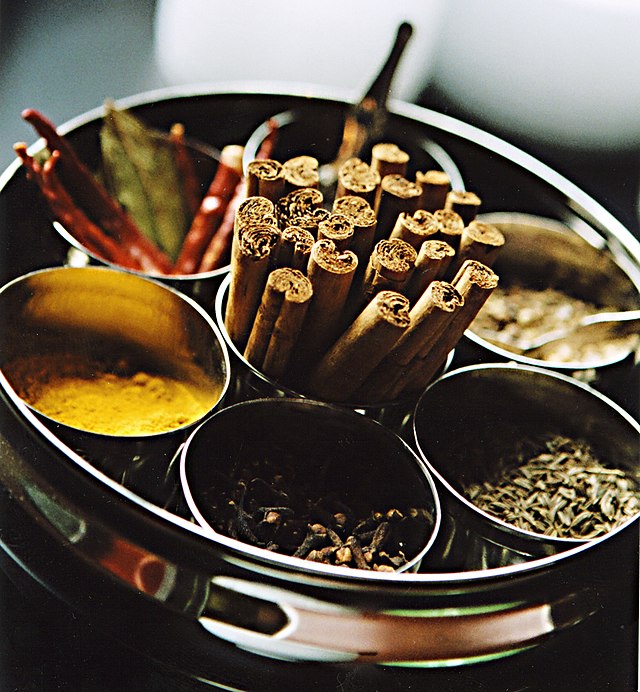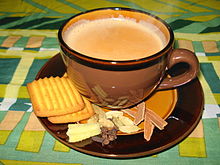Masala chai (/məˈsɑːlə tʃaɪ/; lit. 'mixed-spice tea') is a popular beverage throughout South Asia, originating in India. It is made by brewing black tea (usually crush, tear, curl) in milk and water, and then by sweetening with sugar. Adding aromatic herbs and spices creates masala chai, although chai is often prepared unspiced.[2][3]
This article needs additional citations for verification. (April 2024) |
The term chai originated from the Chinese word for tea, cha via the Hindi chai (चाय). In English, this spiced tea is commonly referred to as chai tea,[4] or simply chai.[5] Originating in India,[1][6] the beverage has gained worldwide popularity, becoming a feature in many coffee and tea houses, with many using the term chai latte or chai tea latte for their version to indicate that it is made with steamed milk, much like that used to make a caffè latte but mixed with a spiced tea concentrate instead of espresso.
History
Tea was introduced to India by the British as a popular beverage. Tea plants have grown wild in the Assam region since antiquity, but historically, Indians viewed tea as a herbal medicine rather than as a recreational beverage.[7]
In the 1830s, the British East India Company became concerned about the Chinese monopoly on tea, which constituted most of its trade and supported the enormous consumption of tea in Great Britain around 1 pound (0.45 kg) per person per year. British colonists had recently noticed the existence of the Assamese tea plants, and began to cultivate tea plantations locally. In 1870, over 90% of the tea consumed in Great Britain was still of Chinese origin, but by 1900, this had dropped to 10%, largely replaced by tea grown in India (50%) and Ceylon (33%).[8]
However, consumption of black tea within India remained low until the promotional campaign by the Indian Tea Association in the early 20th century, which encouraged factories, mines, and textile mills to provide tea breaks for their workers. It also supported many independent chaiwalas throughout the growing railway system.[9]
Tea was promoted as served Indian style, with small added amounts of milk and sugar. The Indian Tea Association initially disapproved of independent vendors' tendency to add spices and greatly increase the proportions of milk and sugar, thus reducing their usage (and thus purchase) of tea leaves per liquid volume. However, chai later firmly established itself as a popular beverage.[10]
Ingredients

Tea
Black tea is typically used as base in most chai recipes. The most common type of black tea is Assam; however, a blend of different tea variations may be used.[11] Assam, Darjeeling, and Nilgiri are the three most common types of tea used in chai in India.[12]
Spices

The spices used in masala chai often include cardamon, ginger, cinnamon, clove, and more. Mint and lemongrass may also be used in masala chai. [13]
Masala chai in western India often excludes clove and black peppercorn. A small amount of salt is often added to chai in the region of Bhopal.[14] The Kashmiri version of chai is brewed with green tea instead of black tea and has a more subtle blend of spices with a pinch of salt. This version is a bit savory and is pink in color, due to the addition of baking soda.[15]
Milk
Traditionally in India, water buffalo milk is used to make chai.[16][17] Although whole milk is usually used in masala chai, alternative dairy milk such as soy milk or skim milk is also a preferred option across the world.[18]
Sweetener
White sugar, brown sugar, Demerara sugar, or honey may be used as sweetener in chai. Jaggery may also be used as a sweetener.[19]
Preparation

Masala chai is composed of three major components: masala, chai (or tea), and milk. Recipes and preparation of chai can vary by geography and by family. One way to prep masala chai is by gently boiling water with spices in a pot. Tea is then added to the pot and brewed to preference. Once brewing is complete, the tea and spice mixture is strained into a cup. Milk or cream can then be added.[20]
A common Maharashtrian practice for preparation of one cup of chai is to first combine one half cup of water with one-half cup of milk in a pot over heat. Sugar may be added at this point or after. Ginger is then grated into the mixture followed by adding a "tea masala". Although the ingredients may vary from region to region, "tea masala" typically consists of crushed ginger, crushed cardamom, lemongrass, cloves, and cinnamon.[21] The mixture is brought to a boil and 1 teaspoon of loose black tea[22] is added.
Benefits
Over the last few years, chai has gained popularity for it complex flavors as well as the numerous health benefits consuming chai provides. The blend of black tea leaves with spices such as ginger, cardamom, cinnamon, cloves, and black pepper provides a rich source of antioxidants.[23] Antioxidants help reduce inflammation and support heart health. Ginger and cinnamon, in particular have shown properties that reduce blood pressure and boost immunity.[23] The combination of spices in chai also offers a warming effect which aids overall digestion and improves circulation. Depending on how it is made, it can have less caffeine content than coffee, making it a better alternative for those with caffeine intolerance.[23]
Consumption in the Indian subcontinent

Small vendors (called chaiwalla in Hindi/cha-ola in Bengali) are found by the side of every highway, road and alley – often the only establishments that will be open through the night. They generally also sell tobacco and snacks. Many will deliver tea to people's places of business in a chaidaan, a wooden or metal frame carrier for cups.[24]
In the metropolitan city of Mumbai, roadside tea stalls serve smaller cups of tea at a lower budget which is referred to as 'cutting chai', the term 'cutting' referring to the halving of quantity contained in a full cup to reduce the cost of the cup of tea.[25]
In Pakistan, masala chai is usually brewed with milk and sweetened with spices like nutmeg, cinnamon and/or cloves.[26]
Consumption beyond the Indian subcontinent

Masala chai is popular in East Africa and the Caribbean.[28][29] It is also quite popular in the GCC; but it is locally known as Karak Tea or Chai Karak (Arabic: شاي كرك, Urdu: کڑک چائے).[30]
In the West
In the West, to better simulate water buffalo milk, one may try using dry or powdered milk, along with the raw or turbinado sugar normally used in India. In addition, as milk consumption in all age groups in the West has started to decrease steadily over the last 50 years, substitutes such as oat and almond milk have emerged as an alternative to water buffalo milk.[31]
As an alternative to the hot tea format, several types of cold "chai" beverages have become popular in the United States. These range in complexity from a simple spiced iced tea without milk to a slush of spiced tea, ice, and milk (or nondairy creamer) mixed in a blender and topped with whipped cream.[32]

Chai with added espresso is called a "dirty chai" in America, as well as "java chai", "red eye chai", "turbocharger", "chai charger", "tough guy chai", etc.[33][34]
See also
References
External links
Wikiwand in your browser!
Seamless Wikipedia browsing. On steroids.
Every time you click a link to Wikipedia, Wiktionary or Wikiquote in your browser's search results, it will show the modern Wikiwand interface.
Wikiwand extension is a five stars, simple, with minimum permission required to keep your browsing private, safe and transparent.

